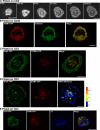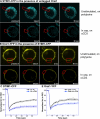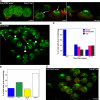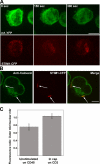Dynamic movement of the calcium sensor STIM1 and the calcium channel Orai1 in activated T-cells: puncta and distal caps
- PMID: 18448669
- PMCID: PMC2441672
- DOI: 10.1091/mbc.e08-02-0146
Dynamic movement of the calcium sensor STIM1 and the calcium channel Orai1 in activated T-cells: puncta and distal caps
Abstract
The proteins STIM1 and Orai1 are the long sought components of the store-operated channels required in T-cell activation. However, little is known about the interaction of these proteins in T-cells after engagement of the T-cell receptor. We found that T-cell receptor engagement caused STIM1 and Orai1 to colocalize in puncta near the site of stimulation and accumulate in a dense structure on the opposite side of the T-cell. FRET measurements showed a close interaction between STIM1 and Orai1 both in the puncta and in the dense cap-like structure. The formation of cap-like structures did not entail rearrangement of the entire endoplasmic reticulum. Cap formation depended on TCR engagement and tyrosine phosphorylation, but not on channel activity or Ca(2+) influx. These caps were very dynamic in T-cells activated by contact with superantigen pulsed B-cells and could move from the distal pole to an existing or a newly forming immunological synapse. One function of this cap may be to provide preassembled Ca(2+) channel components to existing and newly forming immunological synapses.
Figures








References
-
- Barr V. A., et al. T-cell antigen receptor-induced signaling complexes: internalization via a cholesterol-dependent endocytic pathway. Traffic. 2006;7:1143–1162. - PubMed
-
- Brandizzi F., Snapp E. L., Roberts A. G., Lippincott-Schwartz J., Hawes C. Membrane protein transport between the endoplasmic reticulum and the Golgi in tobacco leaves is energy dependent but cytoskeleton independent: evidence from selective photobleaching. Plant Cell. 2002;14:1293–1309. - PMC - PubMed
-
- Bunnell S. C., Barr V. A., Fuller C. L., Samelson L. E. High-resolution multicolor imaging of dynamic signaling complexes in T cells stimulated by planar substrates. Sci STKE. 2003;2003:PL8. - PubMed
Publication types
MeSH terms
Substances
Grants and funding
LinkOut - more resources
Full Text Sources
Miscellaneous

